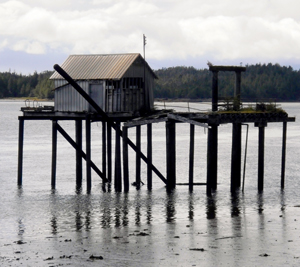EVER GET attracted to someone because he or she has qualities you wish you actually had? Well, I guess I’m that way about fishing villages with restored canneries. Since I hail from a city whose equivalent fruit canneries have been annihilated in favor of condominiums, I recently grew fond of two particular villages in British Columbia and their subsequent salmon canneries: Prince Rupert and Steveston. The resulting double shot of cannery culture filled a gaping hole in my San Jose soul.
Forty miles south of Alaska sits Prince Rupert, and 6 miles from there one finds the desolate labyrinth known as the North Pacific Cannery. An expansive multiplex straddling the Skeena River where a few dozen buildings sit suspended above the water on cylindrical wood pilings, the cannery seems to go on forever.
I scoped out industrial butchering machines, a net loft, rows of former sleeping quarters, a mess hall, a bunkhouse and an aromatic reduction plant, plus numerous other buildings in various states of decay. Snowcapped peaks commandeered the skyline, while cedar and hemlock forests multiplied indefinitely across the landscape. The scenario conveyed a triple shot of abandonment, isolation and loneliness I found to be downright inspiring.
Established in 1889, the cannery operated for almost a century and is the oldest fish cannery on the West Coast of North America. Much of it remains intact, but parts are falling off into the ocean, so locals are banding together and raising funds to ensure it gets properly restored.
On a day when no one else was around, manager of conservation and operations Steve Milum walked me through a never-ending maze of warehouses, ramshackle boardwalks, wooden pathways, ancient administrative offices, rusted tanks and other sordid structures, schooling me on the comprehensive history and ecology of the British Columbia fishing industry.
Components of the complex are adequately fixed up and converted into museum-style displays for public tours, but much more money needs to be raised for the place to achieve full restoration. Nevertheless, the cannery presents an eye-popping throwback to a century ago, when hundreds of canneries occupied the coast of Western Canada.
On the flip side, the Gulf of Georgia Cannery National Historic Site in the thriving fishing village of Steveston provides a restored, more modernized scenario. Located in Richmond, British Columbia, this one operated from 1894 to 1930, but was then revived during World War II as a herring reduction plant.
By contrast, everything is fixed up. The place is a full-blown commercialized museum, containing many of the same industrial machines, but all of which have been turned into public displays. There are placards, films, interactive exhibits and a variety of group tours for kids and adults. Numerous tour guides provide insight into what it was like working at each position on the canning line. There are farmers’ markets outside in the summer and even a concert series on a stage near the entrance. As a result, thousands of tourists who already flock to Steveston make this cannery a regular stop.
Inside, the placards feature retro cartoon diagrams of each stage of the fish-canning process—cleaning, butchering, canning, labeling, steaming and more—replete with arrows, instructions and bilingual descriptions. Le scie eventre le poisson translates as “fish opened by splitting saw,” while le plongeur pousse le saumon dans la cavite becomes “plunger pushes salmon into cavity.”
Our tour guide, a woman wearing a Canadian-red jacket and silver salmon earrings, walked us through every detail of the operation, explaining that back before the butchering machine was invented, workers could butcher four to five fish a minute. Losing a finger was common, she said.
At the end, I felt serene. On one hand, at the upper reaches of the province one finds the North Pacific Cannery, an expansive complex in various stages of restoration. People are banding together, just trying to raise funds to make sure the place doesn’t fall off into the ocean. It’s a long-term project. And at the southern edge of British Columbia, just 10 miles from the U.S. border, the Gulf of Georgia Cannery remains a top tourist draw.
Like an addict, I have gotten my fix of cannery culture to replace what my hometown has lost. I have a new appreciation for all things salmon. Especially earrings.




